专题一 数据结构
空间数据结构
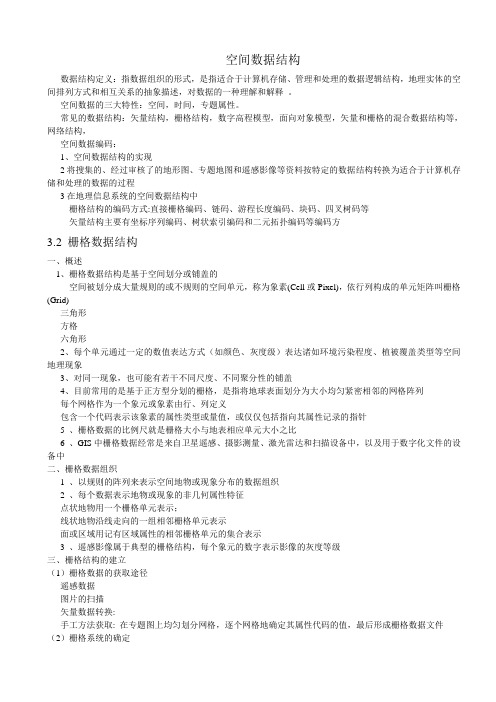
空间数据结构数据结构定义:指数据组织的形式,是指适合于计算机存储、管理和处理的数据逻辑结构,地理实体的空间排列方式和相互关系的抽象描述,对数据的一种理解和解释。
空间数据的三大特性:空间,时间,专题属性。
常见的数据结构:矢量结构,栅格结构,数字高程模型,面向对象模型,矢量和栅格的混合数据结构等,网络结构,空间数据编码:1、空间数据结构的实现2将搜集的、经过审核了的地形图、专题地图和遥感影像等资料按特定的数据结构转换为适合于计算机存储和处理的数据的过程3在地理信息系统的空间数据结构中栅格结构的编码方式:直接栅格编码、链码、游程长度编码、块码、四叉树码等矢量结构主要有坐标序列编码、树状索引编码和二元拓扑编码等编码方3.2 栅格数据结构一、概述1、栅格数据结构是基于空间划分或铺盖的空间被划分成大量规则的或不规则的空间单元,称为象素(Cell或Pixel),依行列构成的单元矩阵叫栅格(Grid)三角形方格六角形2、每个单元通过一定的数值表达方式(如颜色、灰度级)表达诸如环境污染程度、植被覆盖类型等空间地理现象3、对同一现象,也可能有若干不同尺度、不同聚分性的铺盖4、目前常用的是基于正方型分划的栅格,是指将地球表面划分为大小均匀紧密相邻的网格阵列每个网格作为一个象元或象素由行、列定义包含一个代码表示该象素的属性类型或量值,或仅仅包括指向其属性记录的指针5 、栅格数据的比例尺就是栅格大小与地表相应单元大小之比6 、GIS中栅格数据经常是来自卫星遥感、摄影测量、激光雷达和扫描设备中,以及用于数字化文件的设备中二、栅格数据组织1 、以规则的阵列来表示空间地物或现象分布的数据组织2 、每个数据表示地物或现象的非几何属性特征点状地物用一个栅格单元表示;线状地物沿线走向的一组相邻栅格单元表示面或区域用记有区域属性的相邻栅格单元的集合表示3 、遥感影像属于典型的栅格结构,每个象元的数字表示影像的灰度等级三、栅格结构的建立(1)栅格数据的获取途径遥感数据图片的扫描矢量数据转换:手工方法获取: 在专题图上均匀划分网格,逐个网格地确定其属性代码的值,最后形成栅格数据文件(2)栅格系统的确定栅格坐标系的确定:坐标系的确定实质是坐标系原点和坐标轴的确定由于栅格编码一般用于区域性GIS,原点的选择常具有局部性质为了便于区域的拼接,栅格系统的起始坐标应与国家基本比例尺地形图公里网的交点相一致,并分别采用公里网的纵横坐标轴作为栅格系统的坐标轴。
抽象数据类型
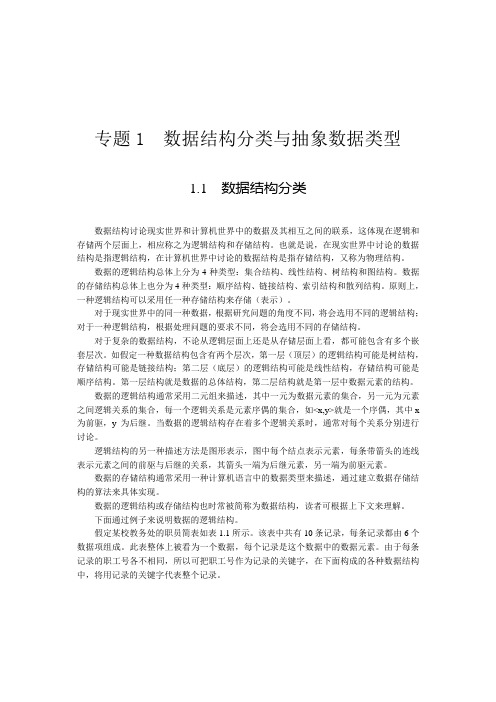
集合结构是整个数据结构中的一种特殊情况,其元素之间不存在任何关系。 【例 1.5】一种数据结构的二元组表示为 B=(K,R),其中
数据的逻辑结构通常采用二元组来描述,其中一元为数据元素的集合,另一元为元素 之间逻辑关系的集合,每一个逻辑关系是元素序偶的集合,如<x,y>就是一个序偶,其中 x 为前驱,y 为后继。当数据的逻辑结构存在着多个逻辑关系时,通常对每个关系分别进行 讨论。
逻辑结构的另一种描述方法是图形表示,图中每个结点表示元素,每条带箭头的连线 表示元素之间的前驱与后继的关系,其箭头一端为后继元素,另一端为前驱元素。
专题 1 数据结构分类与抽象数据类型
5
若数据是线性结构、树结构或图结构,则除了要存储所有数据元素外,还要相应存储元素 之间的线性关系、层次关系或网状关系。
数据的存储结构分为顺序、链接、索引和散列 4 种。 顺序存储对应一块连续的存储空间,该空间的大小要大于等于存储所有元素需占有的 存储空间的大小,存储元素之间的联系(即逻辑结构)通常不需要附加空间,而是通过元 素下标之间的对应关系反映出来,只要简单的计算就可以得到一个元素的前驱或后继元素 的下标。顺序存储空间一般需要通过定义数组类型和数组对象来实现。 在链接存储结构中,元素之间的逻辑关系通过存储结点之间的链接关系反映出来,每 个存储结点对应存储一个元素,同时存储该元素的前驱和后继元素所在结点的存储位置, 或者说同时存储指向其前驱元素结点和后继元素结点的指针,通过这些指针能够直接访问 到其前驱元素和后继元素。链接存储空间通过定义元素的存储结点类型和对象来实现,所 有存储结点可以占用连续的存储空间(即数组空间),也可以占用不连续的存储空间,此 空间是由动态分配的每个结点的空间形成的。 索引存储是首先把所有数据元素按照一定的函数关系划分成若干个子表,每个子表对 应一个索引项,然后采用一种存储结构存储所有子表的索引项和采用另一种存储结构存储 所有子表中的元素。如存储汉字字典时,需要采用索引存储,首先按偏旁部首划分所存汉 字为若干子表,得到偏旁部首表,对于每个部首再按所属汉字的笔画多少划分子表,得到 检字表,检字表中的每个汉字对应汉字解释表(即字典主体)中的一个条目;然后再分别 存储部首表、检字表和汉字解释表。这里检字表是汉字解释表的索引,而偏旁部首表又是 检字表的索引,它是汉字解释表的二级索引。当存储的数据量很大时,通常都需要采用索 引存储,并且时常使用多级索引。 在索引存储中,各级索引表和主表(即数据元素表)通常都以文件的形式保存在外存 磁盘上,访问任一数据元素时,都要根据该数据元素的特征依次访问各级索引表和最后访 问主表,存取外存的次数至少等于建立索引的级数加 1。 散列存储方法是按照数据元素的关键字通过一种函数变换直接得到该元素存储地址的 方法,该存储地址为相应数组空间中的下标位置。用于散列存储所有数据元素的相应数组 空间称为散列表。通过定义用于计算散列存储地址的函数和定义存储数据元素的散列表能 够实现散列存储结构。 以上简要叙述了数据结构的有关概念,在以后的各专题中将会做深入和具体的讨论。
国家计算机二级VFP资料

表对应一个关系; 类型:1:1, n:1, 1:n, m:n 运算:交、并、差(要求两个关系必须具有 更新规则:级联、限制、忽略 相同的结构) 投影(列)、选择(行)、 删除规则:级联、限制、忽略 揑入规则:限制、忽略 自然 连接(相同字段) 完整性:实体完整性(主码/主索引)、域完 整性(有效性规则)、参照完整性(关系)
变量的作用域: ①.公共变量(public):作用于程序运行的始终 ②.局部变量(local):只在本过程中使用,即不上传,也不接收 ③.私有变量(private):不上传、可以接收(默认) 注意:local变量具有隐藏上层模块中建立的同名变量的作用; private变量也具有隐藏上层模块中建立的同名变量的作用。
第二章 第三章 第四章
数据结构与算法
程序设计基础 软件工程基础 数据库设计基础
DB、DBMS、DBS、DBAS () 三级模式:模式(逻辑/概念)、内模式(物理 P16 /存储)、外模式(用户) P15 层次模型、网状模型、关系模型
主关键字与外部关键字(外码)
P13
P32
定义:一个关系就是一张二维表,一张二维 学生与学校两个实体之间的关系属于
二、程序设计基础 1. 程序设计方法与风格。 2. 结构化程序设计。 3. 面向对象的程序设计方法,对象,方法,属性及继承与 多态性。 三、软件工程基础 1. 软件工程基本概念,软件生命周期概念,软件工具与软 件开发环境。 2. 结构化分析方法,数据流图,数据字典,软件需求规格 说明书。 3. 结构化设计方法,总体设计与详细设计。 4. 软件测试的方法,白盒测试与黑盒测试,测试用例设计, 软件测试的实施,单元测试、集成测试和系统测试。 5. 程序的调试,静态调试与动态调试。
硬盘数据结构
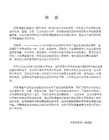
《数据结构》课程标准

01
分支限界策略
类似于回溯法,但在搜索过程中通过 剪枝等操作来减少搜索空间,提高效 率。
05
03
贪心策略
每一步都采取当前状态下最好或最优 的选择,从而希望导致结果是全局最 好或最优的。
04
回溯策略
通过探索所有可能的解来求解问题, 当发现当前路径无法得到解时,回溯 到上一步重新选择。
05
排序与查找算法专题
《数据结构》课程标准
目录
• 课程概述与目标 • 基本数据类型与操作 • 复杂数据类型与操作 • 算法设计与分析基础 • 排序与查找算法专题 • 文件组织与处理技术 • 实验环节与项目实践指导
01
课程概述与目标
数据结构定义及重要性
数据结构定义
数据结构是计算机存储、组织数据的方式,指相互之间存在一种或多种特定关 系的数据元素的集合。
01
02
03
时间复杂度
衡量算法执行时间随问题 规模增长的速度,常用大 O表示法。
空间复杂度
衡量算法执行过程中所需 额外空间的数量级,也常 用大O表示法。
其他指标
包括算法的稳定性、可读 性、可维护性等。
典型算法设计策略
分治策略
将原问题分解为若干个子问题,分别 求解后再合并结果。
02
动态规划
通过保存子问题的解,避免重复计算, 提高效率。
06
文件组织与处理技术
文件概念及分类方法
文件定义
文件是存储在外部介质上的数据集合, 通常以记录为单位进行组织。
文件分类
根据文件的性质和记录的组织方式,文 件可分为顺序文件、索引文件、散列文 件和链式文件等。
顺序文件组织方式
顺序文件的定义
顺序文件是按照某种顺序 (如记录的逻辑顺序或物 理顺序)进行组织的文件。
三个模块,两大单元,一专题

三个模块,两大单元,一专题
您说的“三个模块,两大单元,一专题”可能是在某种教育或培训框架下的一种组织结构。
这种结构将内容分为不同的部分,以便于学习和教学。
1. 三个模块:通常是指三个主要的、互相关联的部分。
每个模块可能涵盖了特定的主题或技能集合。
例如,在编程培训中,一个模块可能涵盖基础语法、数据结构和算法等。
2. 两大单元:这通常指的是在某个大主题下分成的两个主要部分或子主题。
例如,在某个关于历史的课程中,一个单元可能专注于古代历史,另一个单元则专注于中世纪历史。
3. 一专题:这通常指的是一个更为集中、深入的研究或讨论主题。
它可能是一个更为专业或具体的子主题,例如某个历史事件、人物或思想流派。
这样的结构可以帮助组织内容,使其更有条理,并帮助学习者更好地理解和吸收信息。
如果您是在考虑某个特定的课程或培训项目,建议您进一步了解该项目的具体内容,以获得更详细和准确的信息。
空间数据结构

第五章空间数据结构数据结构即指数据组织的形式,是适合于计算机存储、管理和处理的数据逻辑结构。
地理信息系统空间数据结构是指空间数据在系统内的组织和编码形式(GIS数据结构也可称为图形数据格式),它是指适合于计算机系统存储、管理和处理地理图形的逻辑结构。
GIS中,空间数据一般有着较为复杂的数据结构,目前,主要有两种数据模型表示空间数据,即矢量数据模型和栅格数据模型。
4.1 栅格数据结构4.1.1概述栅格数据是计算机和其它信息输入输出设备广泛使用的一种数据模型,如电视机、显示器、打印机等的空间寻址。
甚至专门用于矢量图形的输入输出设备,如数字化仪、矢量绘图仪及扫描仪等,其内部结构实质上是栅格的。
遥感数据也是采用特殊扫描平台获得的栅格数据。
栅格数据就是用数字表示的像元阵列,其中,栅格的行和列规定了实体所在的坐标空间,而数字矩阵本身则描述了实体的属性或属性编码。
栅格数据最显著的特点就是存在着最小的、不能再分的栅格单元,在形式上常表现为整齐的数字矩阵,因而便于计算机进行处理,特别是存储和显示。
4.1.2编码方案以图4-1为例,介绍几种编码方法的编码思路、方案和特点。
图4-1 栅格数据结构1. 游程长度编码地理数据往往有较强的相关性,也就是说相邻象元的值往往是相同的。
游程长度编码的基本思想是:按行扫描,将相邻等值的象元合并,并记录代码的重复个数。
游程长度编码的数据结构: 行号,属性,重复次数。
图4-1的游程长度编码为:1,A,4,R,1,A,6…对于游程长度编码,区域越大,数据的相关性越强,则压缩越大。
其特点是,压缩效率较高,叠加、合并等运算简单,编码和解码运算快。
2. 块式编码块式编码是将游程扩大到二维情况,把多边形范围划分成若干具有同一属性的正方形,然后对各个正方形进行编码。
块式编码的基本思想:由初始位置(行列号)、半径和属性代码组成。
图4-1的块状编码为:(1,1,3,A),(1,5,1,R),(1,6,2,A),…块状编码对大而简单的多边形更为有效,对一些虽不较多的复杂多边形效果并不好。
《数据结构》教学大纲

《数据结构》教学大纲一、课程基本信息二、课程描述(一)课程简介《数据结构》是信息类各专业的核心基础课程,是一门理论与实践相结合的课程,在整个信息相关专业的教学体系中处于举足轻重的地位。
数据结构是设计和实现编译程序、操作系统、数据库系统及其它系统程序和大型应用程序的重要基础。
通过本课程理论和实践的教学,使学生较牢固地掌握数据结构的基本概念、原理、算法,了解算法复杂性的度量方法,初步掌握根据所求解问题的性质选择合理的数据结构,并对时间空间复杂性进行必要的控制,培养和提高学生理论、抽象、设计的能力,掌握数据结构和算法的设计分析技术,提高程序设计的质量,为将来的研究和开发工作打下坚实的基础。
“Data Structures and Algorithms”, one of the most important core courses in Computer Science. The course also covers fundamental data structures and classical algorithms which are widely used in the succeeding specialized courses,such as Operating Systems, Software Engineering, Database Systems, Compiler Principles, Computer Graphics and Human Computer Interaction.What is the combination of data structures and algorithms? Niklaus Wirth wrote a book titled "Algorithms + Data Structures = Programs", which points out their important roles in computing discipline:algorithm and data structure are two closely linked and indivisible parts of programming.The course will follow the idea of“Algorithms + Data Structures = Programs”, aimed at improving students’ knowledge and skills of theory, abstraction and design in problem solving.This course will focus on data structures and algorithms for manipulating them. Data structures for storing information in tables, lists, trees, queues and stacks will be covered. Some basic graph and discrete transform algorithms will also be discussed. On a solid basis of the fundamental theory, the students will analyze the problems using problem, data and algorithm abstraction. Making a tradeoff between space and time complexity, the students will learn how to organize data reasonably, design efficient and effective algorithms, and implement high quality programs, so that they can solve real-world complex problems.After studying the course, the students’ ability of abstract thinking and problem solving should have improvedconsiderably.Their programming skills and the quality of their codes would have increased as well. After studying this course, students should be well prepared for further study, engineering and research in computer related areas.(二)课程教学基本设计本课程由大班授课、小班讨论和实验组成,学时分配分别为48学时、16学时、16学时。
5 GIS数据组织与结构
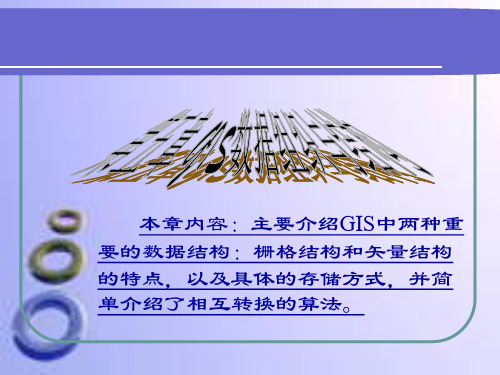
(a)关系结构表Leabharlann (b)层次模型示例-林地数据库
(c)网状模型示例
第三节 空间数据组织与结构
栅格数据结构 矢量数据结构 栅格与矢量数据结构的选择与转换 两种数据结构的优缺点比较
数据结构:指的是数据之间的相互关系,即数据的组织形式。数据元素之间的逻辑关系,也称数据的逻辑结构,是从逻辑关系上描述数据,与数据的存储无关, 是独立于计算机的。数据的逻辑结构可看作是从具体问题抽象出来的数学模型。数据元素及其关系在计算机存储器上的表示,称为数据的存储结构(物理结构),是逻辑结构用计算机语言的实现,它依赖于计算机语言。对机器语言而言,存储结构是具体的。
空间数据库与一般数据库相比,具有:数据量特别大;不仅有地理要素的属性数据,还有大量的空间数据;数据应用广泛。
数据库中的数据组织一般可分为四级:数据项、记录、文件和数据库。数据间的逻辑联系:一对一的联系;一对多的联系;多对多的联系。常用的数据文件:顺序文件、索引文件、直接文件和倒排文件。
数据项:是可以定义数据的最小单位,也叫元素、基本项、字段等,数据项与现实世界实体的属性相对应,数据项有一定的取值范围,称为域。记录:是由若干相关联的数据项组成,是处理和存储信息的基本单位,是关于一个实体的数据总和,构成该记录的数据项表示实体的若干属性。为了标识每条记录,都必须有记录的标识符,也叫“关键字”。 文件:是一给定类型记录的全部具体值的集合,文件用文件名称标识。数据库
重要性法:根据栅格内不同地物的重要性,选取最重要的地物类型决定相应的栅格单元代码。常用于具有特殊意义而面积较小的地理要素。 百分比法:根据矩形区域内各地理要素所占面积的百分比数确定栅格单元的代码。
栅格数据的组织方法主要有以下三种: (1)以栅格单元为记录的序列,不同层上同一像元位置上的各属性值表示为一个列数组(图 (a)); (2)以层为基础,每一层又以像元顺序记录它的坐标和属性值,一层记录完后再记录第二层(图 (b))这种方法较为简单,但需要的存贮空间最大; (3)以层为基础,但每一层内则以多边形为序记录多边形的属性值和充满多边形的各栅格单元的坐标(图(c))。
数据结构关于树专题试题
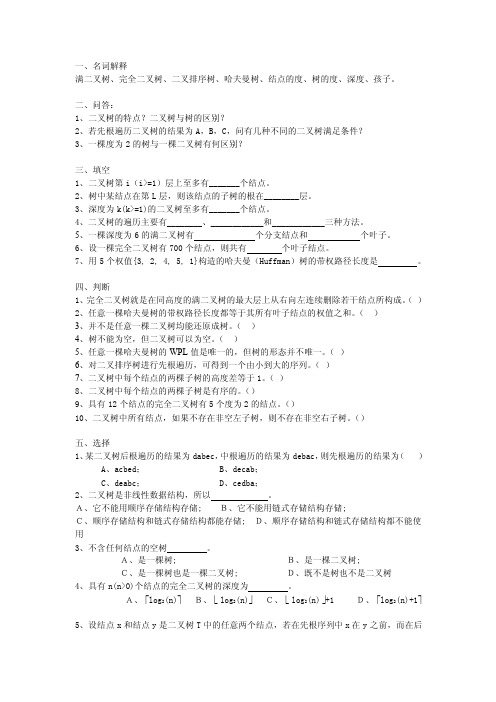
一、名词解释满二叉树、完全二叉树、二叉排序树、哈夫曼树、结点的度、树的度、深度、孩子。
二、问答:1、二叉树的特点?二叉树与树的区别?2、若先根遍历二叉树的结果为A,B,C,问有几种不同的二叉树满足条件?3、一棵度为2的树与一棵二叉树有何区别?三、填空1、二叉树第i(i>=1)层上至多有_______个结点。
2、树中某结点在第L层,则该结点的子树的根在________层。
3、深度为k(k>=1)的二叉树至多有_______个结点。
4、二叉树的遍历主要有________、____________和____________三种方法。
5、一棵深度为6的满二叉树有个分支结点和个叶子。
6、设一棵完全二叉树有700个结点,则共有个叶子结点。
7、用5个权值{3, 2, 4, 5, 1}构造的哈夫曼(Huffman)树的带权路径长度是。
四、判断1、完全二叉树就是在同高度的满二叉树的最大层上从右向左连续删除若干结点所构成。
()2、任意一棵哈夫曼树的带权路径长度都等于其所有叶子结点的权值之和。
()3、并不是任意一棵二叉树均能还原成树。
()4、树不能为空,但二叉树可以为空。
()5、任意一棵哈夫曼树的WPL值是唯一的,但树的形态并不唯一。
()6、对二叉排序树进行先根遍历,可得到一个由小到大的序列。
()7、二叉树中每个结点的两棵子树的高度差等于1。
()8、二叉树中每个结点的两棵子树是有序的。
()9、具有12个结点的完全二叉树有5个度为2的结点。
()10、二叉树中所有结点,如果不存在非空左子树,则不存在非空右子树。
()五、选择1、某二叉树后根遍历的结果为dabec,中根遍历的结果为debac,则先根遍历的结果为()A、acbed;B、decab;C、deabc;D、cedba;2、二叉树是非线性数据结构,所以。
A、它不能用顺序存储结构存储; B、它不能用链式存储结构存储;C、顺序存储结构和链式存储结构都能存储; D、顺序存储结构和链式存储结构都不能使用3、不含任何结点的空树。
《数据结构》课程教学设计方案

《数据结构》课程教学设计方案一、课程的性质和任务《数据结构》是计算机科学与技术专业本科生的一门必修课程。
本课程介绍如何组织各种数据在计算机中的存储、传递和转换。
内容包括:数组、链接表、栈和队列、递归、树与森林、图、堆与优先级队列、集合与搜索结构、排序、索引与散列结构等。
课程采用面向对象的观点讨论数据结构技术,并以兼有面向过程和面向对象双重特色的C++ 语言作为算法的描述工具,强化数据结构基本知识和面向对象程序设计基本能力的双基训练。
为后续计算机专业课程的学习打下坚实的基础。
二、先修课要求面向对象程序设计、计算机数学(离散数学)。
三、课程的教学基本要求1 、掌握重要数据结构的概念、使用方法及实现技术;2 、学会做简单的算法分析,包括算法的时间代价和空间代价。
四、教学方法和教学形式建议面授辅导为主、辅以网上答疑,小组讨论,专题论坛,学生自主观看教学光盘。
教师阶段性的进行作业评讲,总结复习、同时进行必要的上机实验。
五、考试期末考试由中央电大统一命题,统一评分标准,统一考试时间。
学生的本课程成绩按平时的形成性考核成绩满分20 分,期末考试满分80 分分配,合计计算。
六、文字教材及媒体本课程的文字教材包括《数据结构》主教材。
清华大学出版社出版的《数据结构》,殷人昆编著;《数据结构实用教程》作为参考书,徐孝凯编著。
录像媒体:录制30讲,每讲50分钟。
直播课堂:共4讲,每讲50分,前三讲为对教学重点、难点,对教学过程中反映的共性问题和有代表性的问题进行辅导,后一讲为复习辅导和有关考试说明。
七、教学环节有三个教学环节:授课,作业和教学实验,考试。
课程总成绩的记分方法:形成性考核成绩在课程总成绩中占20%,终结性考试成绩在课程总成绩中占80%。
课程总成绩为百分制,60分为合格。
作业及试验:形成性考核的要求和形式:形成性考核的形式有平时作业和课程实验。
能够按时、按质、按量完成平时作业和课程实验者方可得满分。
网上教学:安徽电大教学处主页开放教育专栏有关《数据结构》内容:教学大纲、实施方案、考核说明、课程说明、模拟试题、教学辅导、复习指导、往届试题、重点难点、直播课堂、各章电子教案等;每月更新充实一次。
应用型本科《数据结构》教学研究

21 0 0年 第 3期 中:2 -15 14 2
一
[] 3 闰永 海. 强应用 型本 科财务 管理专业 建设 的思考[] 育教 加 I教 . 学研究,00年 第 3期:3 —16 21 15 3
应用型本科《 数据结构》 教学研穷
广 州大学松 田学院 严 宇
[ 摘 要] 数据结构是计算机科 学与技术专业和信 息管理 与信息 系统专业 的必修课之 一 , 是一 门综合性的 专业基础课 。在 计算机科 学 中, 它不仅是程序设计的重要理论基础 , 而且是设计 和实现操作 系统 、 数据库 系统和大型应用 系统的重要基础 。文章中阐述 了在 应用型本科的教 学过程 中的一些心得体会 , 归纳 总结在授课 , 实验及考试环节 的一 些创 新方法 , 以适应 民办学院在培养 应用型本科
培养在财务管理的筹 资、投资 、用资的某一个领域应具备的单一技能。 E P沙盘模拟与财务管理案例实习相对应的综合实验 主要 培养学生从 R 整个企业的管理角度 出发 , 针对企业在 市场管理 、 生产管理 、 财务 管理 、 人事管理 中出现 的具体经营 问题 , 专业的角度分析 问题 , 而做出决 从 进 策, 提高对财务信息和其他信息 的分析与应用能力 。 () 3 金融类实践课程模块 企业的筹资 、 投资都必然会涉及金 融方面的知识 , 金融管理能力 对 个优秀的财务管理人员来说非常重要 。 因此 , 证券投资类 实践课 程设 置是非常必要的实践教学环节。 应增 加财 务管理 专业 实验 室的建设 , 通 过让学生利用模拟交易系统和证券投资学 的基 本理论知识 、 方法 , 行 进 模 拟股票 、 债券 等金融工具的投资 , 培养 学生金融方面的专业技 能。 34改革财 务管理 专业的教学方法 - 财 务管理 专业教 学方 法改革应根据课程特 点和教学内容引入一些 创新 的教学方法 , 方法主要有 : 这些 情景设 计教 学法 、 案例教 学法 等。 情 景设计教学法是教师先根据课 堂要讲授 的内容 , 结合 案例设计悬念 , 提 出问题 , 以引发学 生的思 考兴趣 , 而为上好一 堂课拉 开了序幕 。比如 : 从 在学 习管理会计本利分析法 时 , 为引人主题 , 可先 以企业 生产经营的相 关案例 引入 , 让学生进行思考 , 最后 引出主题 , 再进行深入学 习。 财务管 理案例教学是在学生学 习和掌握 了一定 的理论知识 的基础上 ,选用或 自 行设计能配合理论教学 的相关 案例 , 通过剖析会计 案例 , 将理论知识 应用于会计实践活动 中, 提高学生发现分析解决实际 问题 的能力 。 另外 , 大多数财务管理相关课 程的考试都采用 闭卷形式 , 考试 内容 主要是理论知识 , 不能很好地体 现学 生使用财务知识 的能力 , 多学生 很 临时抱佛脚 , 也能通过考试 , 因而达不到学 以致用 的目的。 因此 , 部分课
数据结构专题实验

上机实验要求及规范《数据结构》课程具有比较强的理论性,同时也具有较强的可应用性和实践性,因此上机实验是一个重要的教学环节。
一般情况下学生能够重视实验环节,对于编写程序上机练习具有一定的积极性,但是容易忽略实验的总结,忽略实验报告的撰写。
对于一名大学生必须严格训练分析总结能力、书面表达能力。
需要逐步培养书写科学实验报告以及科技论文的能力。
拿到一个题目,一般不要急于编程,而是应该按照面向过程的程序设计思路(关于面向对象的训练将在其它后继课程中进行),首先理解问题,明确给定的条件和要求解决的问题,然后按照自顶向下,逐步求精,分而治之的策略,逐一地解决子问题。
具体步骤如下:1.问题分析与系统结构设计充分地分析和理解问题本身,弄清要求做什么(而不是怎么做),限制条件是什么。
按照以数据结构为中心的原则划分模块,搞清数据的逻辑结构(是线性表还是树、图?),确定数据的存储结构(是顺序结构还是链表结构?),然后设计有关操作的函数。
在每个函数模块中,要综合考虑系统功能,使系统结构清晰、合理、简单和易于调试。
最后写出每个模块的算法头和规格说明,列出模块之间的调用关系(可以用图表示),便完成了系统结构设计。
2.详细设计和编码详细设计是对函数(模块)的进一步求精,用伪高级语言(如类C语言)或自然语言写出算法框架,这时不必确定很多结构和变量。
编码,即程序设计,是对详细设计结果的进一步求精,即用某种高级语言(如C/C++语言)表达出来。
尽量多设一些注释语句,清晰易懂。
尽量临时增加一些输出语句,便于差错矫正,在程序成功后再删去它们。
3.上机准备熟悉高级语言用法,如C语言。
熟悉机器(即操作系统),基本的常用命令。
静态检查主要有两条路径,一是用一组测试数据手工执行程序(或分模块进行);二是通过阅读或给别人讲解自己的程序而深入全面地理解程序逻辑,在这个过程中再加入一些注释和断言。
如果程序中逻辑概念清楚,后者将比前者有效。
4.上机调试程序调试最好分块进行,自底向上,即先调试底层函数,必要时可以另写一个调用驱动程序,表面上的麻烦工作可以大大降低调试时所面临的复杂性,提高工作效率。
严蔚敏《数据结构》(C语言版)笔记和习题(含考研真题)详解

读书笔记
好书啊,严蔚敏数据结构的题集是没有这么详细的答案哇!这书全有!。 重点内容都有介绍,很赞的就是习题部分的解答。
目录分析
1.2强化习题详解
1.1复习笔记
1.3考研真题与典 型题详解
2.2强化习题详解
2.1复习笔记
2.3考研真题与典 型题详解
3.2强化习题详解
3.1复习笔记
3.3考研真题与典 型题详解
4.2强化习题详解
4.1复习笔记
4.3考研真题与典 型题详解
考研真题与典 型题详解
6.2强化习题详解
6.1复习笔记
6.3考研真题与典 型题详解
7.2强化习题详解
7.1复习笔记
7.3考研真题与典 型题详解
9.2强化习题详解
9.1复习笔记
9.3考研真题与典 型题详解
10.2强化习题详解
10.1复习笔记
10.3考研真题与典 型题详解
11.2强化习题详解
11.1复习笔记
11.3考研真题与典 型题详解
作者介绍
精彩摘录
这是《严蔚敏《数据结构》(C语言版)笔记和习题(含考研真题)详解》的读书笔记模板,可以替换为自己 的精彩内容摘录。
谢谢观看
严蔚敏《数据结构》(C语言版)笔 记和习题(含考研真题)详解
读书笔记模板
01 思维导图
03 读书笔记 05 作者介绍
目录
02 内容摘要 04 目录分析 06 精彩摘录
思维导图
本书关键字分析思维导图
习题
数据结构
笔记
名校
复习
重难点
第章
笔记
教材
真题 真题
存储管理
语言版
典型
二叉树
空间数据结构与管理

01
03
02
坐标序列法的优缺点
优点:文件结构简单,易于实现以多边形为单位的运算和显示。 缺点:①多边形之间的公共边界被数字化和存储两次,由此产生冗余和碎屑多边形;如重叠陕长多边形及裂缝的产生。 ②每个多边形自成体系而缺少邻域信息,难以进行邻域处理,如消除某两个多边形之间的共同边界; ③不能解决“洞”和“岛”之类的多边形嵌套问题。 ④没有方便方法来检查多边形边界的拓扑关系正确与否,如有无不完整的多边形(死点)或拓扑学上不能接受的环(奇异多边形)。 这种方法可用于简单的粗精度制图系统中。
Ⅱ树状索引编码法
采用树状索引以减少数据冗余并间接增加邻域信息,方法是对所有边界点进行数字化,将坐标对以顺序方式存储,由点索引与边界线号相联系,以线索引与各多边形相联系,形成树状索引结构。
线与多边形之间的树状索引
图形数据
4
二、矢量数据结构
定位明显:其定位是根据坐标直接存储的,无需任何推算。 属性隐含:属性则一般存于文件头或数据结构中某些特定的位置上。 矢量数据结构图形运算的算法总体上比栅格数据结构复杂的多,在叠加运算、邻域搜索等操作时比较困难,有些甚至难以实现, 在计算长度、面积、形状和图形编辑、几何变换操作中,矢量结构有很高的效率和精度。
02
03
04
手工获取,专题图上划分均匀网格,逐个决定其网格代码。
由矢量数据转换而来。
扫描仪扫描专题图的图像数据{行、列、颜色(灰度)},定义颜色与属性对应表,用相应属性代替相应颜色,得到(行、列、属性)再进行栅格编码、存贮,即得该专题图的栅格数据。
遥感影像数据,对地面景像的辐射和反射能量的扫描抽样,并按不同的光谱段量化后,以数字形式记录下来的像素值序列。
专题梳理1数据与信息相关理论

知识要点2 数据管理与安全
3.保护数据 安全的方法
保护存储 介质
提高数据 本身安全
数据备份、磁盘阵列、异地容灾
数据 加密
替代加密(凯撒加密)、换位加密 (逆序加密)、简单异或
提高数据的保密性
数据 校验
MD5、CRC(奇偶校验)、SHA-1 保证数据的完整性
典型例题
5.有下列数据文件:①wuzhen.bmp ②wuzhen.gif ③
典型例题
9.(2022·6舟山统考高二)有关大数据的说法,正确的是 ( C ) A.大数据一般用于分析抽样数据 B.大数据采集的数据都是结构化数据 C.大数据更加注重事物的相关性 D.用大数据进行处理时,必须保证每个数据都准确无误
解析:选项A,大数据要分析的是全体数据,而不是抽样数据选 项错误;选项B,各种结构化、半结构化和非结构化数据共存是大 数据的普遍现象,选项错误;选项D,对于数据不再追求精确性, 选项错误。
解析 : 符合大数据概念的数据一般具有数据规模大、处理 速度快、数据类型多、价值密度低四个特征,可以用4个V来 概括,即数量(Volume)、速度(Velocity)、多样(Variety)和 价值(Value)选项C符合题意。
典型例题
8.下列有关大数据的说法,正确的是( A ) A.大数据采集的数据有结构化、半结构化和非结构化的 B.大数据分析的是抽样数据 C.用大数据进行数据处理时,必须保证每个数据都准确 无误 D.在大数据时代,数据的主要来源还是人力 解析:大数据分析的是全体数据,而不是抽样数据,选项B错误 ;大数据的价值密度低,在大数据中,发挥价值的仅是其中非常 小的部分,不力求每个数据都准确无误,选项C错误;在大数据时 代,数据主要来源于传感器、互联网、智能终端等,选项D错误。
- 1、下载文档前请自行甄别文档内容的完整性,平台不提供额外的编辑、内容补充、找答案等附加服务。
- 2、"仅部分预览"的文档,不可在线预览部分如存在完整性等问题,可反馈申请退款(可完整预览的文档不适用该条件!)。
- 3、如文档侵犯您的权益,请联系客服反馈,我们会尽快为您处理(人工客服工作时间:9:00-18:30)。
Problem A : Hardwood SpeciesFrom:POJ, 2418DescriptionHardwoods are the botanical group of trees that have broad leaves, produce a fruit or nut, and generally go dormant in the winter.America's temperate climates produce forests with hundreds of hardwood species -- trees that share certain biological characteristics. Although oak, maple and cherry all are types of hardwood trees, for example, they are different species. Together, all the hardwood species represent 40 percent of the trees in the United States.On the other hand, softwoods, or conifers, from the Latin word meaning "cone-bearing," have needles. Widely available US softwoods include cedar, fir, hemlock, pine, redwood, spruce and cypress. In a home, the softwoods are used primarily as structural lumber such as 2x4s and 2x6s, with some limited decorative applications.Using satellite imaging technology, the Department of Natural Resources has compiled an inventory of every tree standing on a particular day. You are to compute the total fraction of the tree population represented by each species.InputInput to your program consists of a list of the species of every tree observed by the satellite; one tree per line. No species name exceeds 30 characters. There are no more than 10,000 species and no more than 1,000,000 trees.OutputPrint the name of each species represented in the population, in alphabetical order, followed by the percentage of the population it represents, to 4 decimal places.Sample InputRed AlderAshAspenBasswoodAshBeechYellow BirchAshCherryCottonwoodAshCypressRed ElmGumHackberryWhite OakHickoryPecanHard MapleWhite OakSoft MapleRed OakRed OakWhite OakPoplanSassafras SycamoreBlack WalnutWillowSample OutputAsh 13.7931Aspen 3.4483 Basswood 3.4483 Beech 3.4483Black Walnut 3.4483 Cherry 3.4483 Cottonwood 3.4483 Cypress 3.4483 Gum 3.4483 Hackberry 3.4483 Hard Maple 3.4483 Hickory 3.4483 Pecan 3.4483 Poplan 3.4483Red Alder 3.4483 Red Elm 3.4483Red Oak 6.8966 Sassafras 3.4483 Soft Maple 3.4483 Sycamore 3.4483 White Oak 10.3448 Willow 3.4483Yellow Birch 3.4483HintThis problem has huge input, use scanf instead of cin to avoid time limit exceeded.Problem B : Nearest Common AncestorsFrom:POJ, 1330DescriptionA rooted tree is a well-known data structure in computer science and engineering. An example is shown below:In the figure, each node is labeled with an integer from {1, 2,...,16}. Node 8 is the root of the tree. Node x is an ancestor of node y if node x is in the path between the root and node y. For example, node 4 is an ancestor of node 16. Node 10 is also an ancestor of node 16. As a matter of fact, nodes 8, 4, 10, and 16 are the ancestors of node 16. Remember that a node is an ancestor of itself. Nodes 8, 4, 6, and 7 are the ancestors of node 7. A node x is called a common ancestor of two different nodes y and z if node x is an ancestor of node y and an ancestor of node z. Thus, nodes 8 and 4 are the common ancestors of nodes 16 and 7. A node x is called the nearest common ancestor of nodes y and z if x is a common ancestor of y and z and nearest to y and z among their common ancestors. Hence, the nearest common ancestor of nodes 16 and 7 is node 4. Node 4 is nearer to nodes 16 and 7 than node 8 is.For other examples, the nearest common ancestor of nodes 2 and 3 is node 10, the nearest common ancestor of nodes 6 and 13 is node 8, and the nearest common ancestor of nodes 4 and 12 is node 4. In the last example, if y is an ancestor of z, then the nearest common ancestor of y and z is y.Write a program that finds the nearest common ancestor of two distinct nodes in a tree.InputThe input consists of T test cases. The number of test cases (T) is given in the first line of the input file. Each test case starts with a line containing an integer N , the number of nodes in a tree, 2<=N<=10,000. The nodes are labeled with integers 1, 2,..., N. Each of the next N -1 lines contains a pair of integers that represent an edge --the first integer is the parent node of the second integer. Note that a tree with N nodes has exactly N - 1 edges. The last line of each test case contains two distinct integers whose nearest common ancestor is to be computed.OutputPrint exactly one line for each test case. The line should contain the integer that is the nearest common ancestor.Sample Input2161 148 510 165 94 68 44 101 136 1510 116 710 216 38 116 1216 752 33 43 11 53 5Sample Output43Problem C : ExpressionsFrom:POJ, 3367DescriptionArithmetic expressions are usually written with the operators in between the two operands (which is called infix notation). For example, (x+y)*(z-w) is an arithmetic expression in infix notation. However, it is easier to write a program to evaluate an expression if the expression is written in postfix notation (also known as reverse Polish notation). In postfix notation, an operator is written behind its two operands, which may be expressions themselves. For example, x y + z w - * is a postfix notation of the arithmetic expression given above. Note that in this case parentheses are not required.To evaluate an expression written in postfix notation, an algorithm operating on a stack can be used. A stack is a data structure which supports two operations:1.push: a number is inserted at the top of the stack.2.pop: the number from the top of the stack is taken out.During the evaluation, we process the expression from left to right. If we encounter a number, we push it onto the stack. If we encounter an operator, we pop the first two numbers from the stack, apply the operator on them, and push the result back onto the stack. More specifically, the following pseudocode shows how to handle the case when we encounter an operator O:a := pop();b := pop();push(b O a);The result of the expression will be left as the only number on the stack.Now imagine that we use a queue instead of the stack. A queue also has apush and pop operation, but their meaning is different:1.push: a number is inserted at the end of the queue.2.pop: the number from the front of the queue is taken out of the queue.Can you rewrite the given expression such that the result of the algorithm using the queue is the same as the result of the original expression evaluated using the algorithm with the stack?InputThe first line of the input contains a number T (T ≤ 200). The following T lines each contain one expression in postfix notation. Arithmetic operators are represented by uppercase letters, numbers arerepresented by lowercase letters. You may assume that the length of each expression is less than 10000 characters.OutputFor each given expression, print the expression with the equivalent result when using the algorithm with the queue instead of the stack. To make the solution unique, you are not allowed to assume that the operators are associative or commutative.Sample Input2xyPzwIMabcABdefgCDEFSample OutputwzyxIPMgfCecbDdAaEBFProblem D : Navigation NightmareFrom:POJ, 1984DescriptionFarmer John's pastoral neighborhood has N farms (2 <= N <= 40,000), usually numbered/labeled 1..N. A series of M (1 <= M < 40,000) vertical and horizontal roads each of varying lengths (1 <= length <= 1000) connect the farms. A map of these farms might look something like the illustration below in which farms are labeled F1..F7 for clarity and lengths between connected farms are shown as (n):F1 --- (13) ---- F6 --- (9) ----- F3| |(3) || (7)F4 --- (20) -------- F2 || |(2) F5|F7Being an ASCII diagram, it is not precisely to scale, of course.Each farm can connect directly to at most four other farms via roads that lead exactly north, south, east, and/or west. Moreover, farms are only located at the endpoints of roads, and some farm can be found at every endpoint of every road. No two roads cross, and precisely one path(sequence of roads) links every pair of farms.FJ lost his paper copy of the farm map and he wants to reconstruct it from backup information on his computer. This data contains lines like the following, one for every road:There is a road of length 10 running north from Farm #23 to Farm #17There is a road of length 7 running east from Farm #1 to Farm #17...As FJ is retrieving this data, he is occasionally interrupted by questions such as the following that he receives from his navigationally-challenged neighbor, farmer Bob:What is the Manhattan distance between farms #1 and #23?FJ answers Bob, when he can (sometimes he doesn't yet have enough data yet). In the example above, the answer would be 17, since Bob wants to know the "Manhattan" distance between the pair of farms. The Manhattan distance between two points (x1,y1) and (x2,y2) is just |x1-x2| + |y1-y2| (which is the distance a taxicab in a large city must travel over city streets in a perfect grid to connect two x,y points).When Bob asks about a particular pair of farms, FJ might not yet have enough information to deduce the distance between them; in this case, FJ apologizes profusely and replies with "-1".Input* Line 1: Two space-separated integers: N and M* Lines 2..M+1: Each line contains four space-separated entities, F1,F2, L, and D that describe a road. F1 and F2 are numbers oftwo farms connected by a road, L is its length, and D is acharacter that is either 'N', 'E', 'S', or 'W' giving thedirection of the road from F1 to F2.* Line M+2: A single integer, K (1 <= K <= 10,000), the number of FB's queries* Lines M+3..M+K+2: Each line corresponds to a query from Farmer Bob and contains three space-separated integers: F1, F2, and I. F1 and F2 are numbers of the two farms in the query and I is the index (1 <= I <= M) in the data after which Bob asks thequery. Data index 1 is on line 2 of the input data, and so on. Output* Lines 1..K: One integer per line, the response to each of Bob'squeries. Each line should contain either a distancemeasurement or -1, if it is impossible to determine theappropriate distance.Sample Input7 61 6 13 E6 3 9 E3 5 7 S4 1 3 N2 4 20 W4 7 2 S31 6 11 4 32 6 6Sample Output13-110HintAt time 1, FJ knows the distance between 1 and 6 is 13.At time 3, the distance between 1 and 4 is still unknown.At the end, location 6 is 3 units west and 7 north of 2, so the distance is 10.Problem E : Binary Search Heap ConstructionFrom:POJ, 1785DescriptionRead the statement of problem G for the definitions concerning trees. In the following we define the basic terminology of heaps. A heap is a tree whose internal nodes have each assigned a priority (a number) such that the priority of each internal node is less than the priority of its parent. As a consequence, the root has the greatest priority in the tree, which is one of the reasons why heaps can be used for the implementation of priority queues and for sorting.A binary tree in which each internal node has both a label and a priority, and which is both a binary search tree with respect to the labels and a heap with respect to the priorities, is called a treap. Your task is, given a set of label-priority-pairs, with unique labels and unique priorities, to construct a treap containing this data.InputThe input contains several test cases. Every test case starts with an integer n. You may assume that1<=n<=50000. Then follow n pairs of strings and numbers l1/p1,...,ln/pn denoting the label and priority of each node. The strings are non-empty and composed of lower-case letters, and the numbers are non-negative integers. The last test case is followed by a zero.OutputFor each test case output on a single line a treap that contains the specified nodes. A treap is printed as (< left sub-treap >< label >/< priority >< right sub-treap >). The sub-treaps are printed recursively, and omitted if leafs.Sample Input7 a/7 b/6 c/5 d/4 e/3 f/2 g/17 a/1 b/2 c/3 d/4 e/5 f/6 g/77 a/3 b/6 c/4 d/7 e/2 f/5 g/1Sample Output(a/7(b/6(c/5(d/4(e/3(f/2(g/1)))))))(((((((a/1)b/2)c/3)d/4)e/5)f/6)g/7)(((a/3)b/6(c/4))d/7((e/2)f/5(g/1)))Problem F : Cube StackingFrom:POJ, 1988DescriptionFarmer John and Betsy are playing a game with N (1 <= N <= 30,000)identical cubes labeled 1 through N. They start with N stacks, each containing a single cube. Farmer John asks Betsy to perform P (1<= P <= 100,000) operation. There are two types of operations:moves and counts.* In a move operation, Farmer John asks Bessie to move the stack containing cube X on top of the stack containing cube Y.* In a count operation, Farmer John asks Bessie to count the number of cubes on the stack with cube X that are under the cube X and report that value.Write a program that can verify the results of the game.Input* Line 1: A single integer, P* Lines 2..P+1: Each of these lines describes a legal operation. Line 2 describes the first operation, etc. Each line begins with a 'M' for a move operation or a 'C' for a count operation. For move operations, the line also contains two integers: X and Y.For count operations, the line also contains a single integer: X.Note that the value for N does not appear in the input file. No move operation will request a move a stack onto itself.OutputPrint the output from each of the count operations in the same order as the input file.Sample Input6M 1 6C 1M 2 4M 2 6C 3C 4Sample Output12Problem G : Find them, Catch themFrom:POJ, 1703DescriptionThe police office in Tadu City decides to say ends to the chaos, as launch actions to root up the TWO gangs in the city, Gang Dragon and Gang Snake. However, the police first needs to identify which gang a criminal belongs to. The present question is, given two criminals; do they belong to a same clan? You must give your judgment based on incomplete information. (Since the gangsters are always acting secretly.)Assume N (N <= 10^5) criminals are currently in Tadu City, numbered from 1 to N. And of course, at least one of them belongs to Gang Dragon, and the same for Gang Snake. You will be given M (M <= 10^5) messages in sequence, which are in the following two kinds:1. D [a] [b]where [a] and [b] are the numbers of two criminals, and they belong to different gangs.2. A [a] [b]where [a] and [b] are the numbers of two criminals. This requires you to decide whether a and b belong to a same gang.InputThe first line of the input contains a single integer T (1 <= T <= 20), the number of test cases. Then T cases follow. Each test case begins with a line with two integers N and M, followed by M lines each containing one message as described above.OutputFor each message "A [a] [b]" in each case, your program should give the judgment based on the information got before. The answers might be one of "In the same gang.", "In different gangs." and "Not sure yet."Sample Input15 5A 1 2D 1 2A 1 2D 2 4A 1 4Sample OutputNot sure yet.In different gangs.In the same gang.Problem H : The RaceFrom:POJ, 2274DescriptionDuring the Annual Interstellar Competition for Tuned Spaceships, N spaceships will be competing. Each spaceship i is tuned in such a way that it can accelerate in zero time to its maximum speed Vi and remain cruising at that speed. Due to past achievements, each spaceship starts at a starting position Xi, specifying how many kilometers the spaceship is away from the starting line.The race course is infinitely long. Because of the high speeds of the spaceships, the race course goes straight all the time. On that straight course, spaceships can pass one another very easily, without interfering with each other.Many people in the audience have not realized yet that the outcome of the race can be determined in advance. It is your task to show this to them, by telling them how many times spaceships will pass one another, and by predicting the first 10 000 times that spaceships pass in chronological order.You may assume that each spaceship starts at a different position. Furthermore, there will never be more than two spaceships at the same position of the course at any time.InputThe first line of the input specifies the number of spaceshipsN (0 < N <= 250 000) that are competing. Each of the next N lines describe the properties of one spaceship. The i+1th line describes the ith ship with two integers Xi and Vi, representing the starting position and the velocity of the ith spaceship (0 <= Xi <= 1 000 000, 0 < Vi < 100). The spaceships are ordered according to the starting position, i.e. X1 < X2 < . . . < XN. The starting position is the number of kilometers past the starting line where the spaceship starts, and the velocity is given in kilometers per second.OutputThe first line of the output should contain the number of times that spaceships pass one another during the race modulo 1 000 000. By publishing the number of passes only modulo 1 000 000, you can at the same time prove your knowledge of it and don't spoil the party for the less intelligent people in the audience.Each of the subsequent lines should represent one passing, in chronological order. If there would be more than 10 000 passings, only output the first 10 000 passings. If there are less than 10 000 passings, output all passings. Each line should consist of two integers i and j, specifying that spaceship i passes spaceship j. If multiple passings occur at the same time, they have to be sorted by their position on the course. This means that passings taking place closer to the starting line must be listed first. The time of a passing is the time when the two spaceships are at the same position.Sample Input40 22 13 86 3Sample Output23 41 2Problem I : Apple TreeFrom:POJ, 3321DescriptionThere is an apple tree outside of kaka's house. Every autumn, a lot of apples will grow in the tree. Kaka likes apple very much, so he has been carefully nurturing the big apple tree.The tree has N forks which are connected by branches. Kaka numbers the forks by 1 to N and the root is always numbered by 1. Apples will grow on the forks and two apple won't grow on the same fork. kaka wants to know how many apples are there in a sub-tree, for his study of the produce ability of the apple tree.The trouble is that a new apple may grow on an empty fork some time and kaka may pick an apple from the tree for his dessert. Can you help kaka?InputThe first line contains an integer N (N≤ 100,000) , which is the number of the forks in the tree.The following N - 1 lines each contain two integers u and v, which means fork u and fork v are connected by a branch.The next line contains an integer M (M≤ 100,000).The following M lines each contain a message which is either"C x" which means the existence of the apple on fork x has been changed. i.e. if there is an apple on the fork, then Kaka pick it; otherwise a new apple has grown on the empty fork.or"Q x" which means an inquiry for the number of apples in the sub-tree above the fork x, including the apple (if exists) on the fork xNote the tree is full of apples at the beginningOutputFor every inquiry, output the correspond answer per line.Sample Input31 21 33Q 1C 2Q 1Sample Output32Problem J : Starry NightFrom:POJ, 1175DescriptionHigh up in the night sky, the shining stars appear in clusters of various shapes. A cluster is a non-empty group of neighbouring stars, adjacent in horizontal, vertical or diagonal direction. A cluster cannot be a part of a larger cluster.Clusters may be similar. Two clusters are similar if they have the same shape and number of stars, irrespective of their orientation. In general, the number of possible orientations for a cluster is eight, as Figure 1 exemplifies.The night sky is represented by a sky map, which is a two-dimensional matrix of 0's and 1's. A cell contains the digit 1 if it has a star, and the digit 0 otherwise.Given a sky map, mark all the clusters with lower case letters. Similar clusters must be marked with the same letter; non-similar clusters must be marked with different letters. You mark a cluster with a lower case letter by replacing every 1 in the cluster by that lower case letter. The order of allocation of letters depends on the first appearance of different clusters, from top to bottom and from left to right.InputYour program is to read from standard input. The first two lines contain, respectively, the width W and the height H of a sky map. The sky map is given in the following H lines, of W characters each.0 <= W (width of the sky map) <= 1000 <= H (height of the sky map) <= 1000 <= Number of clusters <= 5000 <= Number of non-similar clusters <= 26 (a..z)1 <= Number of stars per cluster <= 160OutputYour program is to write to standard output. The output contains the same map as the input, except that the clusters are marked as described above.Sample Input2315100010000000000100000000111110001111100010110101000000010001000111111000000000101010001011110000011101000100000000000001001011111000000000100000010000000000000000010100000011111001000000001000000100010011111000000011101010101000100000010011010001000000000010001110111110000000001000011100000001000000000100010000100010010100000001110001000111000Sample Outputa000a0000000000b00000000aaaaa000ccccc000d0dd0d0a0000000c000c000dddddd000000000c0b0c000d0dddd00000eee0c000c0000000000000e00e0ccccc000000000b000000e00000000000000000b0f000000ccccc00a00000000f000000c000c00aaaaa0000000ddd0c0b0c0a000a000000b00dd0c000c0000000000g000ddd0ccccc000000000g0000ddd0000000e000000000b000d0000f000e00e0b0000000ddd000f000eee000HintJust to make it clearer, notice that this sample input corresponds to the following picture of the sky.Notice that this sample output corresponds to the following picture.Problem K : Mobile phonesFrom:POJ, 1195DescriptionSuppose that the fourth generation mobile phone base stations in the Tampere area operate as follows. The area is divided into squares. The squares form an S * S matrix with the rows and columns numbered from 0 to S-1. Each square contains a base station. The number of active mobile phones inside a squarecan change because a phone is moved from a square to another or a phone is switched on or off. At times, each base station reports the change in the number of active phones to the main base station along with the row and the column of the matrix.Write a program, which receives these reports and answers queries about the current total number of active mobile phones in any rectangle-shaped area.InputThe input is read from standard input as integers and the answers to the queries are written to standard output as integers. The input is encoded as follows. Each input comes on a separate line, and consists of one instruction integer and a number of parameter integers according to the following table.The values will always be in range, so there is no need to check them. In particular, if A is negative, it can be assumed that it will not reduce the square value below zero. The indexing starts at 0, e.g. for a table of size 4 * 4, we have 0 <= X <= 3 and 0 <= Y <= 3.Table size: 1 * 1 <= S * S <= 1024 * 1024Cell value V at any time: 0 <= V <= 32767Update amount: -32768 <= A <= 32767No of instructions in input: 3 <= U <= 60002Maximum number of phones in the whole table: M= 2^30OutputYour program should not answer anything to lines with an instruction other than 2. If the instruction is 2, then your program is expected to answer the query by writing the answer as a single line containing a single integer to standard output.Sample Input0 41 12 32 0 0 2 21 1 1 21 12 -12 1 1 2 33Sample Output34Problem L : Potted FlowerFrom:POJ, 2750DescriptionThe little cat takes over the management of a new park. There is a large circular statue in the center of the park, surrounded by N pots of flowers. Each potted flower will be assigned to an integer number (possibly negative) denoting how attractive it is. See the following graph as an example:(Positions of potted flowers are assigned to index numbers in the range of 1 ... N. The i-th pot and the (i + 1)-th pot are consecutive for any given i (1 <= i < N), and 1st pot is next to N-th pot in addition.)The board chairman informed the little cat to construct "ONE arc-style cane-chair" for tourists having a rest, and the sum of attractive values of the flowers beside the cane-chair should be as large as possible. You should notice that a cane-chair cannot be a total circle, so the number of flowers beside thecane-chair may be 1, 2, ..., N - 1, but cannot be N. In the above example, if we construct a cane-chair in the position of that red-dashed-arc, we will have the sum of 3+(-2)+1+2=4, which is the largest among all possible constructions.Unluckily, some booted cats always make trouble for the little cat, by changing some potted flowers to others. The intelligence agency of little cat has caught up all the M instruments of booted cats' action. Each instrument is in the form of "A B", which means changing the A-th potted flowered with a new one whose attractive value equals to B. You have to report the new "maximal sum" after each instruction.InputThere will be a single test data in the input. You are given an integer N (4 <= N <= 100000) in the first input line.The second line contains N integers, which are the initial attractive value of each potted flower. The i-th number is for the potted flower on the i-th position.A single integer M (4 <= M <= 100000) in the third input line, and the following M lines each contains an instruction "A B" in the form described above.Restriction: All the attractive values are within [-1000, 1000]. We guarantee the maximal sum will be always a positive integer.OutputFor each instruction, output a single line with the maximum sum of attractive values for the optimum cane-chair.Sample Input53 -2 1 2 -542 -25 -52 -45 -1Sample Output4435。
